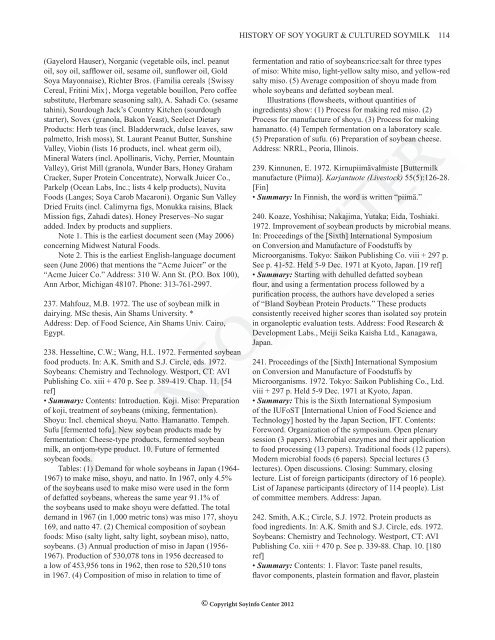history of soy yogurt, soy acidophilus milk and other ... - SoyInfo Center
history of soy yogurt, soy acidophilus milk and other ... - SoyInfo Center
history of soy yogurt, soy acidophilus milk and other ... - SoyInfo Center
You also want an ePaper? Increase the reach of your titles
YUMPU automatically turns print PDFs into web optimized ePapers that Google loves.
(Gayelord Hauser), Norganic (vegetable oils, incl. peanut<br />
oil, <strong>soy</strong> oil, saffl ower oil, sesame oil, sunfl ower oil, Gold<br />
Soya Mayonnaise), Richter Bros. (Familia cereals {Swissy<br />
Cereal, Fritini Mix}, Morga vegetable bouillon, Pero c<strong>of</strong>fee<br />
substitute, Herbmare seasoning salt), A. Sahadi Co. (sesame<br />
tahini), Sourdough Jack’s Country Kitchen (sourdough<br />
starter), Sovex (granola, Bakon Yeast), Seelect Dietary<br />
Products: Herb teas (incl. Bladderwrack, dulse leaves, saw<br />
palmetto, Irish moss), St. Laurant Peanut Butter, Sunshine<br />
Valley, Viobin (lists 16 products, incl. wheat germ oil),<br />
Mineral Waters (incl. Apollinaris, Vichy, Perrier, Mountain<br />
Valley), Grist Mill (granola, Wunder Bars, Honey Graham<br />
Cracker, Super Protein Concentrate), Norwalk Juicer Co.,<br />
Parkelp (Ocean Labs, Inc.; lists 4 kelp products), Nuvita<br />
Foods (Langes; Soya Carob Macaroni). Organic Sun Valley<br />
Dried Fruits (incl. Calimyrna fi gs, Monukka raisins, Black<br />
Mission fi gs, Zahadi dates). Honey Preserves–No sugar<br />
added. Index by products <strong>and</strong> suppliers.<br />
Note 1. This is the earliest document seen (May 2006)<br />
concerning Midwest Natural Foods.<br />
Note 2. This is the earliest English-language document<br />
seen (June 2006) that mentions the “Acme Juicer” or the<br />
“Acme Juicer Co.” Address: 310 W. Ann St. (P.O. Box 100),<br />
Ann Arbor, Michigan 48107. Phone: 313-761-2997.<br />
237. Mahfouz, M.B. 1972. The use <strong>of</strong> <strong>soy</strong>bean <strong>milk</strong> in<br />
dairying. MSc thesis, Ain Shams University. *<br />
Address: Dep. <strong>of</strong> Food Science, Ain Shams Univ. Cairo,<br />
Egypt.<br />
238. Hesseltine, C.W.; Wang, H.L. 1972. Fermented <strong>soy</strong>bean<br />
food products. In: A.K. Smith <strong>and</strong> S.J. Circle, eds. 1972.<br />
Soybeans: Chemistry <strong>and</strong> Technology. Westport, CT: AVI<br />
Publishing Co. xiii + 470 p. See p. 389-419. Chap. 11. [54<br />
ref]<br />
• Summary: Contents: Introduction. Koji. Miso: Preparation<br />
<strong>of</strong> koji, treatment <strong>of</strong> <strong>soy</strong>beans (mixing, fermentation).<br />
Shoyu: Incl. chemical shoyu. Natto. Hamanatto. Tempeh.<br />
Sufu [fermented t<strong>of</strong>u]. New <strong>soy</strong>bean products made by<br />
fermentation: Cheese-type products, fermented <strong>soy</strong>bean<br />
<strong>milk</strong>, an ontjom-type product. 10. Future <strong>of</strong> fermented<br />
<strong>soy</strong>bean foods.<br />
Tables: (1) Dem<strong>and</strong> for whole <strong>soy</strong>beans in Japan (1964-<br />
1967) to make miso, shoyu, <strong>and</strong> natto. In 1967, only 4.5%<br />
<strong>of</strong> the <strong>soy</strong>beans used to make miso were used in the form<br />
<strong>of</strong> defatted <strong>soy</strong>beans, whereas the same year 91.1% <strong>of</strong><br />
the <strong>soy</strong>beans used to make shoyu were defatted. The total<br />
dem<strong>and</strong> in 1967 (in 1,000 metric tons) was miso 177, shoyu<br />
169, <strong>and</strong> natto 47. (2) Chemical composition <strong>of</strong> <strong>soy</strong>bean<br />
foods: Miso (salty light, salty light, <strong>soy</strong>bean miso), natto,<br />
<strong>soy</strong>beans. (3) Annual production <strong>of</strong> miso in Japan (1956-<br />
1967). Production <strong>of</strong> 530,078 tons in 1956 decreased to<br />
a low <strong>of</strong> 453,956 tons in 1962, then rose to 520,510 tons<br />
in 1967. (4) Composition <strong>of</strong> miso in relation to time <strong>of</strong><br />
HISTORY OF SOY YOGURT & CULTURED SOYMILK 114<br />
© Copyright Soyinfo <strong>Center</strong> 2012<br />
fermentation <strong>and</strong> ratio <strong>of</strong> <strong>soy</strong>beans:rice:salt for three types<br />
<strong>of</strong> miso: White miso, light-yellow salty miso, <strong>and</strong> yellow-red<br />
salty miso. (5) Average composition <strong>of</strong> shoyu made from<br />
whole <strong>soy</strong>beans <strong>and</strong> defatted <strong>soy</strong>bean meal.<br />
Illustrations (fl owsheets, without quantities <strong>of</strong><br />
ingredients) show: (1) Process for making red miso. (2)<br />
Process for manufacture <strong>of</strong> shoyu. (3) Process for making<br />
hamanatto. (4) Tempeh fermentation on a laboratory scale.<br />
(5) Preparation <strong>of</strong> sufu. (6) Preparation <strong>of</strong> <strong>soy</strong>bean cheese.<br />
Address: NRRL, Peoria, Illinois.<br />
239. Kinnunen, E. 1972. Kirnupiimävalmiste [Butter<strong>milk</strong><br />
manufacture (Piima)]. Karjantuote (Livestock) 55(5):126-28.<br />
[Fin]<br />
• Summary: In Finnish, the word is written “piimä.”<br />
240. Koaze, Yoshihisa; Nakajima, Yutaka; Eida, Toshiaki.<br />
1972. Improvement <strong>of</strong> <strong>soy</strong>bean products by microbial means.<br />
In: Proceedings <strong>of</strong> the [Sixth] International Symposium<br />
on Conversion <strong>and</strong> Manufacture <strong>of</strong> Foodstuffs by<br />
Microorganisms. Tokyo: Saikon Publishing Co. viii + 297 p.<br />
See p. 41-52. Held 5-9 Dec. 1971 at Kyoto, Japan. [19 ref]<br />
• Summary: Starting with dehulled defatted <strong>soy</strong>bean<br />
fl our, <strong>and</strong> using a fermentation process followed by a<br />
purifi cation process, the authors have developed a series<br />
<strong>of</strong> “Bl<strong>and</strong> Soybean Protein Products.” These products<br />
consistently received higher scores than isolated <strong>soy</strong> protein<br />
in organoleptic evaluation tests. Address: Food Research &<br />
Development Labs., Meiji Seika Kaisha Ltd., Kanagawa,<br />
Japan.<br />
241. Proceedings <strong>of</strong> the [Sixth] International Symposium<br />
on Conversion <strong>and</strong> Manufacture <strong>of</strong> Foodstuffs by<br />
Microorganisms. 1972. Tokyo: Saikon Publishing Co., Ltd.<br />
viii + 297 p. Held 5-9 Dec. 1971 at Kyoto, Japan.<br />
• Summary: This is the Sixth International Symposium<br />
<strong>of</strong> the IUFoST [International Union <strong>of</strong> Food Science <strong>and</strong><br />
Technology] hosted by the Japan Section, IFT. Contents:<br />
Foreword. Organization <strong>of</strong> the symposium. Open plenary<br />
session (3 papers). Microbial enzymes <strong>and</strong> their application<br />
to food processing (13 papers). Traditional foods (12 papers).<br />
Modern microbial foods (6 papers). Special lectures (3<br />
lectures). Open discussions. Closing: Summary, closing<br />
lecture. List <strong>of</strong> foreign participants (directory <strong>of</strong> 16 people).<br />
List <strong>of</strong> Japanese participants (directory <strong>of</strong> 114 people). List<br />
<strong>of</strong> committee members. Address: Japan.<br />
242. Smith, A.K.; Circle, S.J. 1972. Protein products as<br />
food ingredients. In: A.K. Smith <strong>and</strong> S.J. Circle, eds. 1972.<br />
Soybeans: Chemistry <strong>and</strong> Technology. Westport, CT: AVI<br />
Publishing Co. xiii + 470 p. See p. 339-88. Chap. 10. [180<br />
ref]<br />
• Summary: Contents: 1. Flavor: Taste panel results,<br />
fl avor components, plastein formation <strong>and</strong> fl avor, plastein












